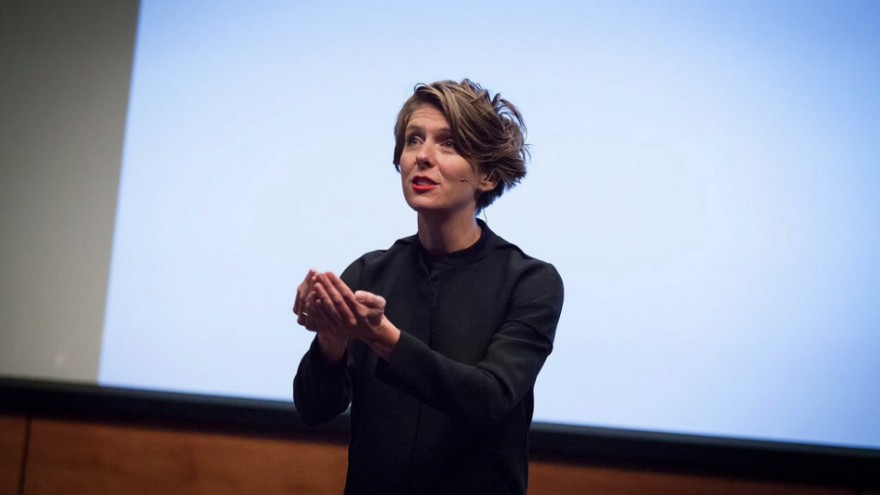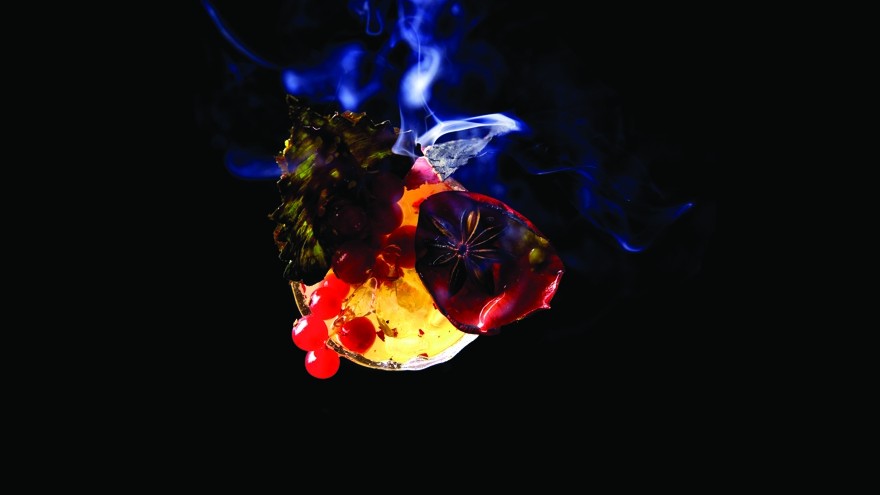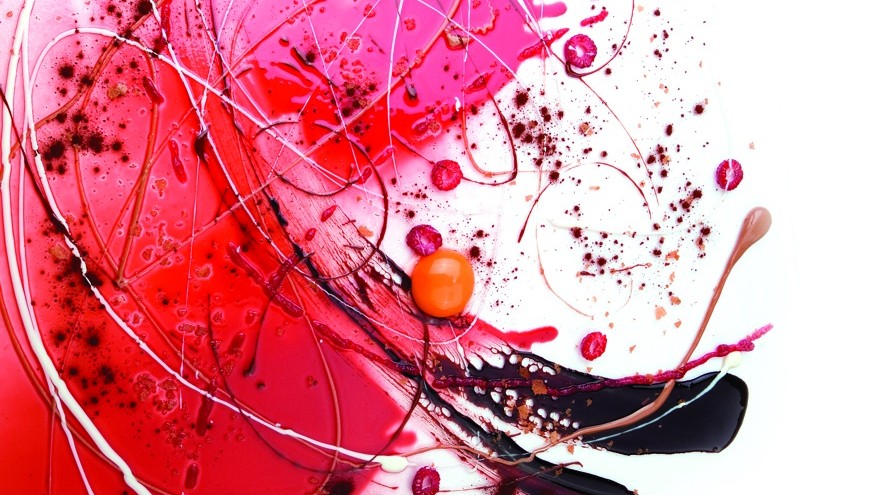We last interviewed Emilie Baltz for our Food Fight series in 2011. There she shared her imaginative approach to changing the growing appetite of consumers for milk and meat, by saying that vegetables, fruits, seeds and grains need to become more desirable through communications campaigns and education. Baltz is full of interesting ideas that engage with human experience in both fun and serious ways. We caught up with her to ask how she designed her multi-sensory, multi-dimensional career:
At a cocktail party, how do you explain what you do to someone who has never met you?
Usually I try to make some sort of interpretive dance move that reveals my underlying belief that “everything is better as a plié”. Seriously. This is always the hardest question to answer. The easiest way I have found to describe what I do is “dinner theatre” – scripts, performances and props that open new possibilities in our relationship to food.
When did you know that you wanted to be a food designer/curator (and is that an accurate title/description)?
For my entire life I’ve wanted to be “everything”. I’ve wanted to be a dancer, a florist, a lawyer, the president, a masseuse, a chef, a mom, a rock star, and more... Studying industrial design appealed to me in my mid-20s because it offered a space for creative exploration within this kind of possibility and (re)invention. As I started my practice in this space I quickly became disillusioned with the realities of the industry. I wanted to work closer to my audience and, quite literally, “taste” the creative process more fully. Food offered this opportunity – both in its multi-sensory qualities as a material, as well as its ability to immediately, and joyfully, bring people together.
Once I tasted that, there was no going back. And thus I invented my own practice to fulfil those needs.
That said, today I think I am further from being a “designer” than I ever have been. I know firmly that I am a storyteller (perhaps with more colouring of performance art than industrial design). I do curate, I do design, I do cook, I do photograph, but in essence, the underlying thread is to tell new, beautiful stories of possibility that engage audiences in a physical and emotional interaction. Design originally appealed to me for this reason and, as noted above, food provided the material for a deeper physical and emotional exploration therein. Today I continue to return to my design fundamentals and the process of creativity it taught me, but the artefacts of my practice have more to do with performance and choreography than objects and products.
The sorts of projects you initiate and get involved in seem too fantastical and whimsical for words. The Lickestra, for example, or Traces or Junk Foodie. How do the ideas for your projects come about and then how do you go about producing them?
The mind is a treasure trove. But the body is gold. The best ideas come from doing and mixing.
Rare is the project that is highly premeditated; rather, I often make first, then understand what the idea is.
The subconscious speaks to us through art and I find that the best way to come up with ideas is to listen to that part of my self while playing, doodling and exploring. Once I find an idea that has a spark, I start fleshing it out: writing stories, sketching scenarios and illustrating moods for how it might exist in the world.
The next part is to find a producing partner who fits the context of the work. Sometimes projects are online, some need to be live – whatever it might be, good partnerships are essential for delivering work at its highest potential. That said, I have honed a great network of like-minded colleagues who are interested in similar explorations. If there’s one thing to maintain in life, it’s your network. Without each other we are lost.
On the flip side, do you sometimes have ideas that aren’t possible to implement/produce?
Every. Single. Second. Of. The. Day. There is still so much to make! For example, who wants to produce the first bubblegum spaceship with me?!
What was the first way-out or unusual project you worked on and how did that come about?
The funny thing about “way-out” is that yesterday’s definition is immediately usurped by today’s. What I thought was “way-out” 10 years ago is now ancient history. I’ve done lots of weird and wonderful things in this lifetime, but the first truly unusual project I worked on was most likely the first story I wrote as a five year-old: it was about M&M’s going to space. They had their own planet, their own spaceship, very long legs (to support their funny spherical torsos) and definitely a ton of fun (plus a romance or two in there). We had a class in first grade called “Young Authors”. I was enamoured with these candies (especially since they were a rare occurrence in our French household). I ended up winning a prize for the story. My teacher then sent my book to the Mars Corporation and I got a t-shirt sent back. I still remember the note: "Dear Emilie, We look forward to seeing your future work!"
I laugh heartily when I think of that. I’ve met the Mars Corporation since then and always bring up that story. Who knew it was the harbinger of things to come?
A nice takeaway from this anecdote is a reminder of the importance that our early childhood has in defining our true selves. I think that’s when we are the purest of materials… the dreams and hopes and imagination we express in these years are the key to true differentiation. As much as I may question my path (as any normal human does), this story has always brought me back on track.
Do you collaborate a lot on purpose or do you find, for the sorts of projects you want to stage, that it’s imperative to rope in specialists (such as chefs) in other areas to make them successful?
I collaborate for two reasons: 1) I LOVE PEOPLE! I love love love people. I am continually fascinated with human behaviour and only learn more about myself when in collaboration.
2) Delegation is freedom. The projects that I make – now more than ever – require many moving parts. Working as a team is the only way to execute them.
You say in your personal statement that having an American parent and a French parent played a central role in the definition of your personal identity – that the difference between the two cultures for you was how people ate, where they ate and what they ate with. How did you eat growing up, where did you have family meals and what did you eat with in both countries?
This was a defining moment in my life – we grew up in Joliet, IL, with a French mother and an American father. My mother brought her culinary traditions to our household, which meant that we ate at 8pm (instead of 5pm like our American friends). We had full, three-course meals every night: entrée, salad, dessert. In that order. Never together. And we always ate as a family. Always. Sunday night was the exception, when we made pizza together and got to eat on the couch while watching TV. I would say that my culinary experiences growing up were more European than American.
The last time we featured your work on Design Indaba it was about your Food Bank – a mobile sound booth for people to record their food memories. Is that project still going on?
Food Bank is not presently running, but I do have goals to continue developing it.
You’re going to be lecturing at the newly established Food Business School. Can you tell us a bit about how your involvement with the school came to be, what you will be lecturing on and how you go about structuring your curriculum?
The Food Business School is a collaboration between CIA (Culinary Institute of America) and William Rosenzweig (founder of the Republic of Tea, among other food ventures). I met William at an event at MIT last year and had the opportunity to discuss this endeavour. Our goals and values seemed aligned seeing as education is dear to my heart, as is food. I have proposed two courses that bring my playful approach to creativity into the food business landscape:
Tell us a bit about the two immersive dining experiences you created as a “social practice project” during your residency at Bemis Center for Contemporary Arts, and also about being a resident for museum-led incubator New Inc. And what is a social practice project?
Here is the overview text for the Bemis project. This is the best definition of social practice [theory within psychology that seeks to determine the link between practice and context within social situations].
I am personally drawn to this methodology due to everything I’ve stated prior: social practice brings together education, investigation, collaboration and activation. Within this system, I believe true change can emerge for both individuals and communities. The work at Bemis this fall was a full immersion in the local community as I collaborated with artists, mixologists, chefs, dancers, musicians, academics and fabricators to bring to life these two immersive performances that helped shed new light onto the institution itself, as well as the personal practices of all the collaborators.
The incubator at New Inc has the same goal: to foster collaboration between diverse artistic disciplines. Though the outputs are not yet defined for this space, what is inspiring is to be at the intersection of creative processes and learn from each other. I’ve always felt alone in my life. This is the first time that I feel like I belong somewhere. One of my favourite thinkers, Richard Sennett, speaks of the importance of liminality for the health of cities. I also believe this for humans – when at the edges, when confronted with each other, with diverse likes, dislikes, opinions, smells, tastes and sounds, we have possibility open in front of us.
You’re about to begin your Food Design class at Pratt Institute in New York. What do you teach in that class and how will the curriculum be different from the one-week summer workshop course you gave in Paris last year?
My course at Pratt focusses on developing a material understanding of food through the sensory sciences and then expanding it into a series of practical applications from product to experience. This year I am team teaching with Terri Lee, a great friend and wonderful food designer with expertise in food service and hospitality.
The class serves as a survey for designers to understand how food can be used as a material for design, as well as an opportunity for them to create their own voice in this area and develop a new personal relationship to food.








